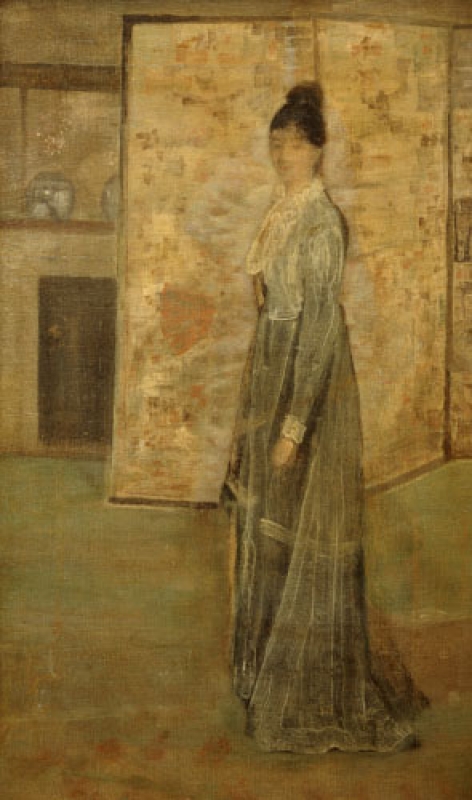Home > Catalogue > Browse > Arrangement in Flesh Colour and Grey: The Chinese Screen << >>
Provenance
- In or before 1910: Walter Thomas Spencer (1864-1936), a second-hand bookseller at 27 New Oxford Street, sold 'rolls of canvases' to Frida Uhl Strindberg (1872-1943);
- 1910, September: Mme Strindberg sold about fifty canvases to Messrs Dowdeswell;
- 1910: on 15 September Dowdeswell showed Elizabeth Robins Pennell (1855-1936) an unsigned painting, which matches the description of Arrangement in Flesh Colour and Grey: The Chinese Screen;
- 1917: sold by Messrs Dowdeswell at auction, Christie's, London, 9 February 1917 (lot 309) as 'The Chinese Screen; an arrangement in Flesh-colour and grey' by Walter Greaves (1846-1930), and bought by 'Martin' for 25 guineas.
- 1924: sold by a private collector through the Leicester Galleries to Maud Field (Mrs H. G. Clegg) (1872-1933);
- 1933: on her death, passed to her daughter, Laura Kathleen Clegg, Lady Ismay (1897-1978);
- 1965: given to her daughter, Sarah Field Ismay (Viscountess Allendale) (1928-2021), Stocksfield-on-Tyne, Northumberland.
- After 1980: acquired for a private collection.
The early provenance of this painting is unknown.
It has been suggested that the history of Arrangement in Flesh Colour and Grey: The Chinese Screen goes back to Whistler's bankruptcy in 1879, when the Receiver, James Waddell (1838-1892), gave Whistler permission to destroy unfinished work. There is, however, no proof that this painting was among the destroyed works.
Arrangement in Flesh Colour and Grey: The Chinese Screen is associated with a group of paintings that may or may not have been originally painted by Whistler. The recorded history of this group starts in 1910.
In 1910 Elizabeth Robins Pennell (1855-1936) and Joseph Pennell (1860-1926) were shown a very large group of paintings by the London art dealers Messrs Dowdeswell and Dowdeswell. 1 Joseph Pennell speculated that these rolls of canvases might have come from Walter Greaves (1846-1930), or 'directly or indirectly', from Charles Augustus Howell (1840?-1890) or his heirs. 2
Walter Dowdeswell (1858-1929) described the history of these canvasses as he understood it. Walter T. Spencer, a second-hand bookseller at 27 New Oxford Street, sold 'rolls of canvases' to Frida Strindberg 'for nothing'; and in September 1910 Mme Strindberg sold 'about fifty' to Messrs Dowdeswell, who described the paintings as 'shockingly dirty but they saw passages that were unmistakably Whistler'. 3 On 15 September Dowdeswell showed Elizabeth Robins Pennell (1855-1936) an unsigned painting of an interior,
‘a woman, with black hair done up high on her head, wearing a grey dress, standing in front of a Japanese screen, a mantelpiece not unlike the mantelpiece in "The Little White Girl" behind it, not particularly good but the skirt was absolutely the Whistler of "The Six Projects": evidently a study of Miss Spartali for "La Princess du Pays de la Porcelaine".' 4
This description fits Arrangement in Flesh Colour and Grey: The Chinese Screen but the Pennells were wrong in suggesting that it was a study of Marie Spartali (Mrs W. J. Stillman) (1844-1927) for La Princesse du pays de la porcelaine [YMSM 050].
Furthermore, it would appear that doubts grew as to the authorship of Arrangement in Flesh Colour and Grey: The Chinese Screen, which was sold as by Walter Greaves (1846-1930) by Messrs Dowdeswell in 1917. 5
Exhibitions
It was not exhibited in Whistler's lifetime.
Last updated: 4th June 2020 by Margaret






